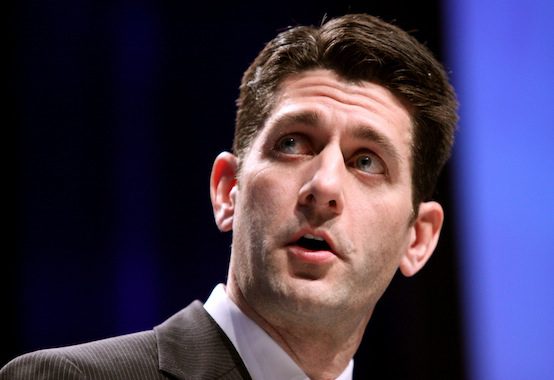How Draconian Is the Ryan Plan?

With the Romney campaign’s selection of Paul Ryan for the VP slot, the pundits have naturally focused again on the Fiscal Year 2013 House Budget Resolution, or what is popularly known as “the Ryan Plan.” Progressive critics deride the proposal as a merciless product of Randian thinking, but in reality it is quite timid. Even if everything happened exactly as called for in the Ryan Plan, the federal budget wouldn’t be balanced for another twenty-seven years. Indeed, if Romney and Ryan are elected and can implement the Plan with no opposition, they will still add far, far more debt in their two terms than Bill Clinton did. Is this really the work of a serious policy wonk who understands how dire our fiscal situation is?
Before diving into the numbers, let’s refresh our memories as to the reaction from many on the left when the news first broke. To take just one example, here is Ryan Lizza in a New Yorker post from August 11, 2012, the morning of the announcement:
Presumably, Romney’s main reason for picking Ryan is … his more recent rise to celebrity as a crusading policy wonk determined to tame the federal government. Romney, who has been extremely vague about what he would do if elected, will now own Paul Ryan’s ideas, which include privatizing Social Security, turning Medicare into a voucher program, bloc-granting and drastically cutting Medicaid, and reducing discretionary spending to levels that would affect every popular government program. This Ryan agenda will now fill the vacuum created by Romney’s unwillingness to lay out the specifics of his own plan. Even before this (apparent) announcement, Democrats were planning on tying Romney to Ryan’s policy platform. Now Romney has done it for them.
Yet the most Absurd Quotation award goes to Jacob Weisberg, whom Paul Krugman cited when Romney picked Ryan. Back in 2011 in his Slate column, Weisberg originally had thought Paul Ryan was a serious policy wonk, but then apologized to his readers for being hoodwinked by the Congressman and dishonest right-wingers:
After my last column, I got pummeled in the liberal blogosphere for asserting that the Ryan budget represented a big step in the direction of conservative honesty. I deserved some of the abuse. Though I criticized Ryan for his unsupported rosy assumptions (shame on you, Heritage Foundation hacks), I reacted too quickly and didn’t sort out just how laughable Ryan’s long-term spending projections were. His plan projects an absurd future, according to the Congressional Budget Office, in which all discretionary spending, now around 12 percent of GDP, shrinks to 3 percent of GDP by 2050. Defense spending alone was 4.7 percent of GDP in 2009. With numbers like that, Ryan is more an anarchist-libertarian than honest conservative.
So, is this analysis right? Is Ryan’s budget plan so fiscally conservative, that it actually crosses over into “anarchist-libertarian” territory?
Hardly. The first jaw-dropping fact—in light of the commentary above—is that Ryan’s plan doesn’t even call for a balanced budget until the year 2040. Don’t believe me? Read it for yourself on page 84 of the actual proposal [.pdf]. There, the analysis proudly declares: “The CBO estimates that this budget [i.e. the Ryan proposal] will produce annual surpluses by 2040 and begin paying down the national debt after that.”
Indeed, if you look at Table S-1 (p. 88), you will see that the Ryan budget estimates that over its first ten years, it will add $3.1 trillion to the federal debt held by the public. Over that decade, the lowest the deficit gets (in absolute dollar terms) is $166 billion in Fiscal Year 2018, and at the end of the decade—i.e., in FY 2022—the Ryan Plan projects the federal budget deficit will have risen back up to $287 billion. Remember everyone, this estimate of a $287 billion federal budget deficit occurs in the tenth year after the Ryan Plan kicks in.
Another interesting fact: Over the first decade of reform, the Ryan Plan calls for federal spending to average 20.0% of real GDP. Yet as the below chart from the St. Louis Fed shows, the ratio of Net Federal Outlays over GDP has typically been far less:
As the chart shows, federal spending exceeded 20 percent of GDP from the Carter years onward, with the notable exception of the Bill Clinton presidency (perhaps because of the Republican Congress). Speaking of the Clinton years, during his tenure (from FY 1993 to FY 2001), the federal debt held by the public increased a grand total of…$72 billion. (See Appendix F in the CBO’s recent fiscal outlook. Remember that there were a few on-budget surpluses during these years.) Compare this to the Ryan Plan, which during its first eight years calls for an increase in the public debt of $2.7 trillion.
In conclusion, regardless of whether the Ryan Plan is specific enough about its revenue forecasts and spending provisions, the simple fact is that even on its own terms the budget resolution is woefully inadequate. It doesn’t even pretend to balance the budget for almost three decades. Far from being “anarchist-libertarian,” it shouldn’t even qualify as serious or conservative.
Robert P. Murphy is author of The Politically Incorrect Guide to Capitalism. His blog is Free Advice. Follow him on Twitter.
